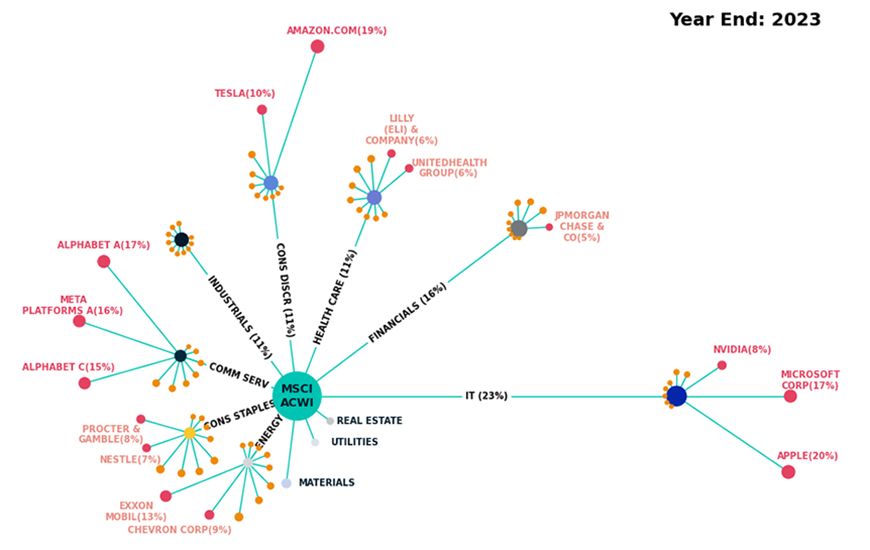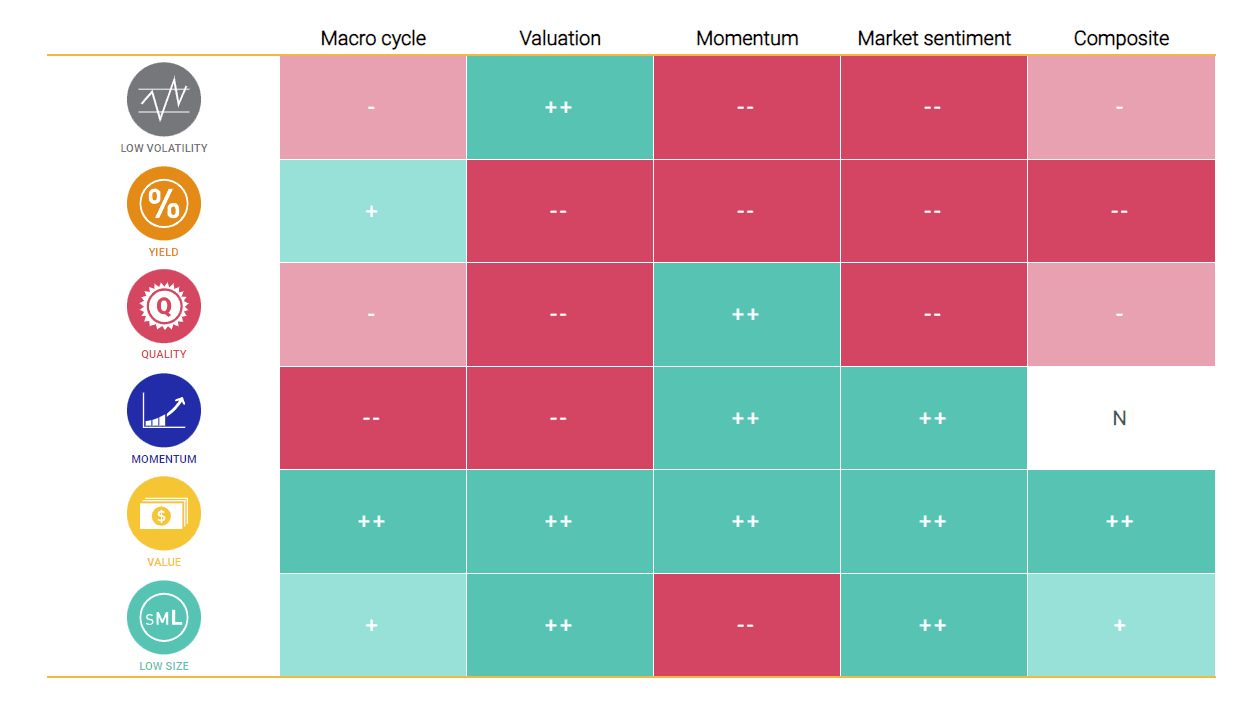Markets in Focus: Concentrating on Diversification
Key findings
- The MSCI ACWI Index was up 22.8% in 2023, led by an outsized contribution from the “Magnificent Seven.”
- Higher equity and bond correlation combined with increased index concentration suggest a review of top-down allocations across regional, country, sector, style and thematic exposures for adequate diversification.
- The MSCIAdaptiveMulti-Factor Allocation Model pointedtoan overweight in value and low size as of Dec. 31, 2023.
We enter 2024 with the prospect of moderate economic growth and easing inflation. But despite the positive sentiment of equity markets and the bond market recovery in Q4, geopolitical risks and macroeconomic uncertainties have not yet abated. Over the last year, bond investors faced significant bouts of market volatility, and equity investors faced high levels of market concentration. The cumulative weight of the top 10 constituents of the MSCI ACWI Index was 18.4% at year-end, the highest since 1994. This record-high concentration has motivated investors to reassess their diversification across regional, country, sector, style and thematic exposures and to review potential equity opportunities through a valuation lens.
In this blog post, we analyze equity-index concentration and valuation, beginning with a brief review of the trends in index performance over the last four years. We also highlight investors' limited ability to lower downside risk through bond allocations since 2020.
2020s: Equities rallied, bonds struggled
Data based on the annualized gross returns in USD of the MSCI indexes from January 2020 through December 2023. "IG" is investment grade and "HY" is high yield.
In the first four years of this decade, bonds have performed exceptionally poorly. In contrast, broad measures of the equity market generally experienced positive annual returns, with the U.S. market, proxied by the MSCI USA Index, posting the highest performance among the indexes we analyzed.
The poor performance of bonds over this period was compounded by the diminished diversification benefits of holding bonds as a hedge against equity-market declines. In 15 months over the last four years, U.S. equity returns fell below -2%. In 12 of these 15 months, as shown below, the return on the 10-year U.S. Treasury was also negative. These joint sell-offs stand in strong contrast to the previous 20 years in which bonds tended to rise in value during major equity bear markets. Our previous research on this topic indicated that high levels of inflation, as experienced in recent years, tended to coincide with diminished diversification benefits.
Bonds did not pay off when it mattered
The U.S. Treasury return is computed using the 10-year constant-maturity U.S. Treasury yield, retrieved from the Federal Reserve Bank of St. Louis's FRED database. The U.S. equity return is the return of the MSCI USA Index. Data is from January 2020 to December 2023.
To mitigate this combination of reduced diversification benefits and higher index concentration, reassessing top-down asset allocation and broadening equity exposure across regions, countries, sectors, styles and themes could create more-resilient portfolios. Integrating thematic exposures in a portfolio — for example, the theme of transformational technologies — could add potential growth opportunities, particularly in mid- and small-cap firms.
In 2023, the equity rally did not lift all boats
Last year emerged as a transformative period for equity investors, marked by the explosive growth of artificial intelligence and the dominance of the Magnificent Seven mega-cap stocks (Apple Inc., Microsoft Corp., NVIDIA Corp., Amazon.com Inc., Meta Platforms Inc., Tesla Inc. and Alphabet Inc.), collectively worth more than USD 10 trillion. These stocks contributed 39.8% of the total return (22.8%) of the MSCI ACWI Index, accounting for a 16.9% weight in the index. As we stated in our mid-year Markets in Focus blog post, the idiosyncratic nature of the Magnificent Seven's returns had an outsized impact on active returns across a broad range of MSCI indexes.
In 2023, developed markets (DM), 24.4%, outperformed emerging markets (EM), 10.3%, which were weighed down by China's -11.0% return, proxied by the MSCI China Index. Large caps outperformed midcaps, and U.S. equities outperformed European equities, 27.1% and 20.7%, respectively.
Among MSCI's style-factor indexes, quality delivered positive active returns across all regions except Europe. Quality's strong showing suggests investors rewarded companies that had stable earnings, low leverage and high profitability in the environment of higher rates. Thematic indexes classified as transformative technologies outperformed the MSCI ACWI Index by a wide margin. Outside of this category, thematic indexes had a challenging year, with the sole exception being smart cities.
Quality outperformed in most regions, value in EM and Asia
Loading chart...
Please wait.
The table shows regional variations of market-cap and non-market-cap MSCI indexes from January 2023 through December 2023. The bar chart shows the active returns of the same indexes, by region or country, for each quarter in the year as well as for the full year. The indexes are the MSCI ACWI Index, MSCI World Index, MSCI World ex USA Index, MSCI Emerging Markets Index, MSCI USA Index, MSCI Europe Index, MSCI AC Asia ex Japan Index and MSCI Japan Index.
Re-visiting top-down allocations under concentration and valuation lens
The outsized returns from mega-cap stocks have not only led to a significant increase in the concentration of market-capitalization-weighted indexes, but also to concentration in specific Global Industry Classification Standard (GICS®)[1] sectors and the stocks within certain sectors. In the video at the end of the blog post, we show the historical sector weights of the MSCI ACWI Index and the top 10 stocks by weight within each sector from Dec. 31, 1995, to Dec. 31, 2023. The following exhibit shows the sector weights and top 10 stocks in each sector at the end of 2023.
Magnificent Seven led to unprecedented concentration

Over the last nearly 30 years, while sectors, such as industrials in 1998 and energy in 2009, have been concentrated, their index weights have not been as high as the current 22.9% weight of information technology (IT). In recent years, the top 10 stocks by weight in the MSCI ACWI Index triggered higher concentration within and across global sector exposures. For example, concentration in the IT sector increased because of Apple, Microsoft and NVIDIA, in the consumer-discretionary sector because of Amazon and Tesla, and in the communication-services sector because of Alphabet and Meta.
In the EM countries, we found a similar pattern of increased concentration from, and within, the IT sector due to the large exposure from Taiwan Semiconductor Manufacturing Company Ltd. and Samsung Electronics Co., Ltd. Europe had higher exposure to industrial stocks but, within that sector, concentration declined as Siemens AG's dominance retreated over time.
Across a broad range of MSCI indexes, we evaluated the concentration contributed from each index's top 10 stocks, from the perspectives of weight, earnings share and risk contribution as of Dec. 31, 2023. We made the following observations:
- Weight concentration: The MSCI ACWI, MSCI World and MSCI USA Indexes, as well as their respective sector indexes, had high levels of concentration, driven by their top 10 constituent stocks. In contrast, concentration in the MSCI indexes in EM and Europe was muted.
- Earnings-share concentration: The MSCI USA Index had a high concentration of earnings, roughly 23%, compared to the MSCI ACWI, MSCI EAFE and MSCI Emerging Markets Indexes, with each accounting for less than 10% of their respective index earnings.
- Risk concentration: The combined risk contribution (34%) of the top 10 stocks in the MSCI USA Index was higher than their aggregate weight suggested, primarily due to their high volatility. Risk was less concentrated in the equity markets of the U.K., Europe and India.
US highly concentrated in earnings share and risk contribution
Loading chart...
Please wait.
Data as of Dec. 31, 2023. Size of the data points in the scatter plot is proportional to the square root of the market cap of the indexes. The indexes are the MSCI AC Asia ex Japan Index, MSCI ACWI Index, MSCI EAFE Index, MSCI Emerging Markets Index, MSCI European Economic and Monetary Union (EMU) Index, MSCI Europe Index, MSCI USA Index and MSCI World Index.
Given the high concentration in global equity indexes at the end of 2023, largely attributable to the U.S. market, investors may wish to re-evaluate their top-down allocations to regions, countries, sectors, factors and themes to ensure their portfolios reflect their desired levels of diversification.
We analyzed the valuations of several MSCI indexes, using the ratio of forward price to earnings (forward P/E) over the period from January 2000 through December 2023, to help investors identify areas of potential opportunity as we enter 2024. The MSCI ACWI, MSCI World and MSCI USA Indexes had among the highest forward P/Es on Dec. 31, 2023, which also happened to be above their average historical ratios. In comparison, the MSCI Europe, MSCI China and MSCI Canada Indexes were trading at lower valuations in absolute terms at the end of Q4 2023, as well as in a historical context.
Europe and China trading at lower historical valuations
Loading chart...
Please wait.
Data is from January 2000 through December 2023. The indexes are the MSCI AC Asia ex Japan Index, MSCI ACWI Index, MSCI EAFE Index, MSCI Emerging Markets Index, MSCI European Economic and Monetary Union (EMU) Index, MSCI Europe Index, MSCI USA Index and MSCI World Index.
What the MSCI Adaptive Multi-Factor Allocation Model indicates
Our adaptive multi-factor framework is a model designed to analyze factor-based decisions. Our research suggests the value in taking a holistic approach to factor assessment. This approach encompasses not only the macroeconomic environment as discussed above, but also factor valuations, recent performance trends and risk sentiment.
As of Dec. 31, 2023, the MSCI Adaptive Multi-Factor Allocation Model showed an overweight to value and low size relative to an equally weighted factor mix as shown below.
Exposures from MSCI Adaptive Multi-Factor Allocation Model

Data as of Dec. 31, 2023. Positive exposures are denoted as + or ++, negative as - or -- and neutral as N.
MSCI ACWI Index market concentration: highest-weighted stocks within sectors
Subscribe todayto have insights delivered to your inbox.
1 GICS is the global industry classification standard jointly developed by MSCI and S&P Global Market Intelligence.
The content of this page is for informational purposes only and is intended for institutional professionals with the analytical resources and tools necessary to interpret any performance information. Nothing herein is intended to recommend any product, tool or service. For all references to laws, rules or regulations, please note that the information is provided “as is” and does not constitute legal advice or any binding interpretation. Any approach to comply with regulatory or policy initiatives should be discussed with your own legal counsel and/or the relevant competent authority, as needed.


